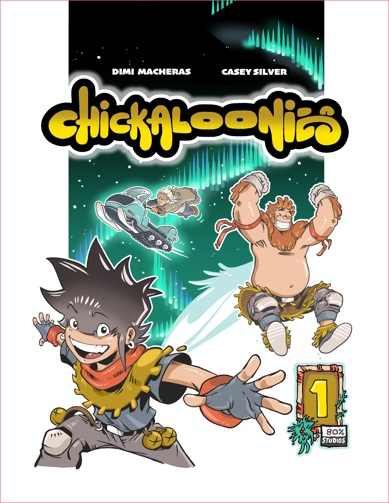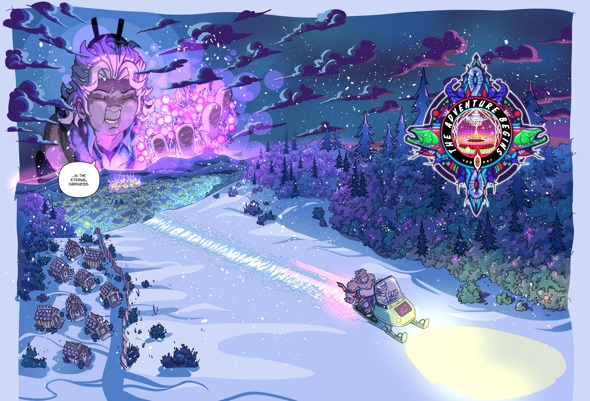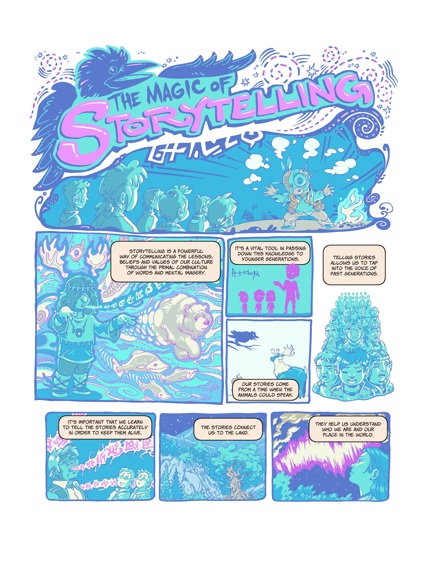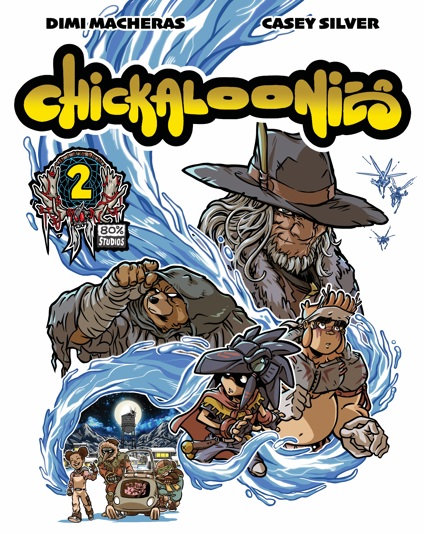
Artist Dimi Mancheras talks comic origins, influences, and advice to his younger self
April 2024
 Dimi Macheras is an Ahtna Athabascan visual artist and Chickaloon Village Tribal Citizen. He was raised by his storyteller mother Patricia Wade and taught Ahtna cultural values and traditions by his grandmother, Clan Elder Katherine Wade. An alumni of Ya Ne Dah Ah School, Alaska’s first Tribally owned and operated full time K-12 school, Dimi began his journey as an artist illustrating his family’s traditional Ahtna stories into graphic novels. He also helped design Ahtna language learning computer programs for Chickaloon Village’s Education Department. He has teamed with storytellers and culture-bearers from other tribes to help turn their legends into graphic novels. In 2010, he co-founded 80% Studios and has self-published a variety of projects, including in the recently released graphic novel Chickaloonies: First Frost. Dimi currently resides in Seattle, WA.
Dimi Macheras is an Ahtna Athabascan visual artist and Chickaloon Village Tribal Citizen. He was raised by his storyteller mother Patricia Wade and taught Ahtna cultural values and traditions by his grandmother, Clan Elder Katherine Wade. An alumni of Ya Ne Dah Ah School, Alaska’s first Tribally owned and operated full time K-12 school, Dimi began his journey as an artist illustrating his family’s traditional Ahtna stories into graphic novels. He also helped design Ahtna language learning computer programs for Chickaloon Village’s Education Department. He has teamed with storytellers and culture-bearers from other tribes to help turn their legends into graphic novels. In 2010, he co-founded 80% Studios and has self-published a variety of projects, including in the recently released graphic novel Chickaloonies: First Frost. Dimi currently resides in Seattle, WA.
Anchorage Museum: What is your background with comics? When and how did you start?
Dimi Macheras: I got into comics back in the early 1990s. At that time a handful of the top artists from Marvel teamed up and left to start Image Comics, which was all new, all original characters created by these guys who were the best of the best. They wanted to make their own characters and tell their own stories that they had full control over. It was one of the most exciting moments of my life. They were rockstars and those comic books were a huge part of me and my friends’ life.
AM: What was the first comic you remember reading? What was the first one that had a significant impact and/or made you want to become a comic artist?
DM: I think the first comics I actually read were Teenage Mutant Ninja Turtles comics from Archie Comics. Just like most kids my age, the Turtles cartoon and toys were everything to me. So I just liked to see what new mutants would show up because the way they portrayed animals with human characteristics fascinated me. But then I found out about the original black and white Turtles comics by Eastman and Laird. Woah, they were gritty, dark, violent. It was awesome, exactly what a ten-year-old kid would think is the coolest thing ever. Around that same time my friend at school was from Korea. One day he showed up to class wearing a Dragonball shirt with Son Goku on his flying nimbus cloud and monkey tail swinging a red bo staff. I was shook. The art, the character, the playfulness of the design. It was quite possibly the best art I’d ever seen up to that point in my life. He had some of the manga at home and when I looked through those pages, Akira Toriyama’s art and storytelling (even though I couldn’t read the Korean translation) truly captivated me. I think it actually planted the seed of wanting to draw comic books.

AM: What are the major themes or issues you address in your art and storytelling?
DM: I’ve worked on a range of different subjects, but once I met my 80% co-creator/storyteller extraordinaire Casey Silver, we started creating stories that we wanted to tell. Just like the Image Comics creators who wanted to make all original characters and comics, we have never really had the goal to work for Marvel or make Superman books. Our creations are of two minds but we strive to create a story which seems to come from one person, which comes out basically like something our 12-year-old selves would like. In our current book Chickaloonies, the theme is storytelling. The two main characters are on a quest to become the greatest storytellers in the world. So, autobiographical? [Laughs] Kinda. But they are Athabascan, like me, so we are exploring the concepts of Indigenous culture and storytelling and how it can be uniquely conveyed through the medium of the graphic novel. And [another theme is] to always respect elders!
AM: What makes a great comic/comic artist?
DM: Maybe it’s better to describe what a “bad” comic is to answer this question. You can tell when someone makes a comic book only as a way to sell a script to a tv or movie studio, like a screenplay basically. There’s a lot of that stuff nowadays especially with all the superhero movies. The art can be spectacular, or the writer can be some mega hotshot amazing talent, right? But show me a comic that a movie executive in a boardroom would throw away and never consider. A great comic can capture both hemispheres of your brain, words and pictures in this harmonious balance, guiding you into a story in only a way a comic book can. I’ve read comics that look like they were scrawled on a bar napkin in a filthy alley which made me laugh and cry. That’s the beauty of comics, you can be a “bad” drawer, or a “lousy” writer, but if you understand the true art of sequential storytelling, your story can rise above all that Hollywood stuff any day! (Draw comics, kids!)
AM: Have you ever been involved in a museum exhibition before?
DM: My work has been featured in a few exhibits before. I remember a big one was a Captain Cook installation where my art was blown up really large and layered like a shadowbox, depicting a few different moments during his voyages. But Lines of Sight is altogether something way beyond anything I’ve ever had the honor to be a part of before. Making comics, I’m so used to drawing and printing my art very small for reading or viewing on a computer or phone. Being able to experience my art at such a large scale is amazing! It inspires me to want to explore more environmental designs, and filling spaces with my art.

AM: What have you learned from participating?
DM: Comic books can be community building. Seeing so many happy faces during the opening was something I’ll never forget. If you hand somebody a comic book, there’s a high likelihood they won’t take the time to enjoy it. But if you put that same person in one of the Lines of Sight galleries, alongside other visitors experiencing comic book art on such a grand scale, it shows how incredible this medium truly is. I think one thing that really connects Nathan, David and I is that in our own unique ways, our comic work is part of something else beyond the book which connects with people and invites them into the pages of our stories. Whether it’s Nathan’s augmented reality, David’s painting, or Chickaloonies' live storytelling, it’s all part of a broader narrative. Comics are for everyone!
AM: Which is better (and why), a comic with fantastic art but a lousy story, or a comic with a great story but sub-par artwork?
DM: Both can be good or bad. Oftentimes lousy art can enhance the experience if the writing style fits with the mood of the book, be it quirky and funny, or dark and depressing. And sometimes the art is so fire that you don’t want to be hindered by the writing and all you need are some sick one-liners and epic sound effects. Ultimately you want to read a comic that knows it’s a comic and fully embraces the experience of turning pages to sequentially reveal a story through words and pictures. There’s something for everyone in comics and it’s not up to me to say what floats your boat!
 AM: What piece of advice would you give to any aspiring young comic artist? What piece of advice would you give to your younger self?
AM: What piece of advice would you give to any aspiring young comic artist? What piece of advice would you give to your younger self?
DM: It’s never too late to begin drawing or writing! I admire people who can make comics on their own, but for Casey and I, our greatest strength is collaboration. Maybe you don’t feel like you’re a great storyteller, I didn’t. I loved drawing pictures and coming up with crazy characters but it was always a challenge to put those ideas into a story framework for some reason. It’s kinda the opposite for Casey where he has all these great ideas for stories but not the ability to draw them out. But together we can make something we envision. It takes work to collaborate, to practice how to bounce ideas around. The advice I’d give to a young comic artist is to always keep practicing drawing, and keep having fun. If you have the choice always draw what makes you happy, and follow that. If you want to make comics, you gotta make them! And share them, even if you’re afraid or embarrassed. The sooner you start, the sooner you’ll be the next awesome comic creator. And if you find you don’t have what it takes to turn your pictures into a story, then find someone to collaborate with. Be it a friend, a family member, even your grandma! Try to find someone as passionate about creating as you are, and begin figuring out how words and pictures become stories. If there’s a piece of advice I’d give to my younger self, dang. I’d say: "I know you love drawing characters, but force yourself to start drawing comic pages and stories! Even if the stories aren’t that good, by practicing drawing sequential art, you’re building that muscle of comic book skill which will help so much the further you evolve as an artist."